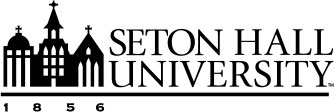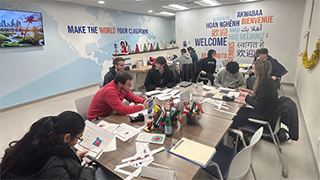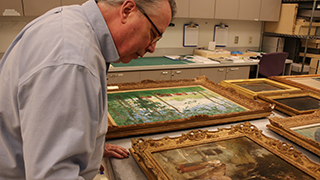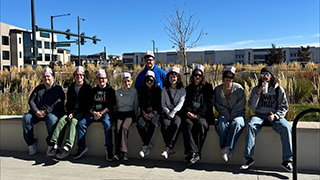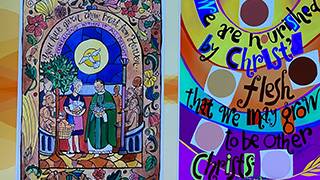Marius Pelmus Receives Dean’s Outstanding Publication Award for Groundbreaking Work in Materials Chemistry
Thursday, May 8, 2025
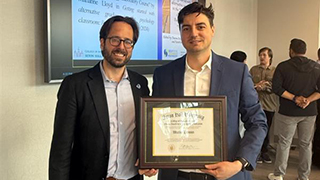
Dean Jonathan Farina pictured with Marius Pelmus, accepting his award.
The Department of Chemistry and Biochemistry is proud to congratulate Marius Pelmus, Ph.D., on receiving the Dean’s Outstanding Publication Award, in recognition of his outstanding scholarship and commitment to advancing research within Seton Hall University. His recent publication: "Synthesis, X-ray structures, and optical and magnetic properties of Cu(II) octafluoro-octakisperfluoro (isopropyl) phthalocyanine: The effects of electron addition and fluorine accretion," featured in the flagship journal of the Inorganic Division of the American Chemical Society, exemplifies the highest standards of academic excellence and collaboration.
Pelmus’s research is part of a broader, ongoing program in materials science, a field that lies at the cutting-edge of interdisciplinary discovery. At its core, the project centers on the design and development of what Pelmus describes as “immortal” organic materials, which are capable of interacting with photons, electrons and ions. These materials have already shown promise in several critical applications, including catalysis, analytical chemistry, anticancer biomaterials, and electrochemical devices. The work has the potential to lead to advances in photodynamic therapy and to establish more sustainable sources for electronics manufacture. The study stands out for its use of advanced techniques such as X-ray diffraction, Electron Paramagnetic Resonance (EPR), and magneto-structural correlation analysis conducted at cryogenic temperatures. These tools were made possible through collaboration with premier research institutions around the world.
In fact, global collaboration was key to the success of this project. Working with scientists from Kyoto University in Japan and the University of Moscow in Russia, Pelmus and his team were able to explore the materials’ properties in greater depth. These collaborations weren’t just logistical accomplishments; they opened doors to discovery. By sharing methodologies and building upon similar compound structures, the international teams pushed the boundaries of what these materials could do. A transformative moment came when the compounds, initially insulating and unable to conduct electricity, were converted into a salt derivative. Much like the difference between pure water and saltwater, the new form of the compound exhibited remarkable electrical conductivity and magnetic properties, surprising even the researchers involved. The result was a rare type of material with exceptional stability that formed 3D crystalline structures and provided the full atomic-level profile of their behavior. This type of breakthrough underscores the importance of thinking outside the box, of not giving up when initial attempts fail. For Pelmus, the research process serves as a powerful reminder: materials can evolve, properties can change, and scientific progress often emerges from persistence, collaboration and creative problem-solving.
It is equally important to Pelmus that students are involved in this journey. As a proud Seton Hall Ph.D. alumnus himself, he views mentoring undergraduate students as a way to share the knowledge accumulated and a duty to sharpen the students’ minds. The lab is filled with energetic young researchers with prior high school research experience, who are learning not only chemistry, but also the essential academic skills of citation, scientific documentation, and organization. Pelmus emphasizes that training students to think clearly and work methodically fosters ambition, empowering them to pursue scholarships, grants and professional research opportunities. Their successes, he says, are largely their own, but their failures are a reflection of how well we prepare them.
Collaborative research at Seton Hall, both within departments and across international borders, offers these students exposure to real-world science on a global scale. Working with rare materials, managing limited quantities, and coordinating across time zones and languages are all part of the learning experience. When the team discovered that their salt derivatives could grow into rare, stable crystalline structures, materials that reveal hidden properties through their 3D geometry, it was a shared triumph.
Pelmus’s award-winning work not only strengthens the research profile of the Department of Chemistry and Biochemistry but also affirms the value of interdisciplinary collaboration, global partnerships, and hands-on student mentorship. It sets a high standard for future research and inspires a spirit of discovery that resonates throughout the Seton Hall academic community. To learn more about the Department of Chemistry and Biochemistry and other research opportunities available, please check their website here.
Categories: Research, Science and Technology
